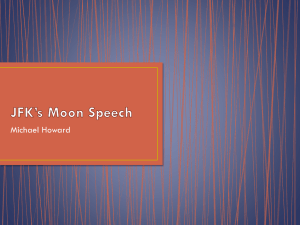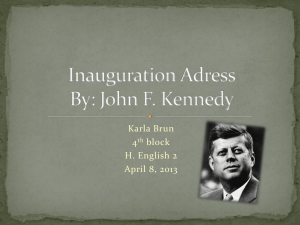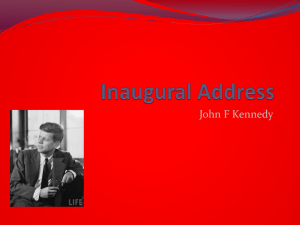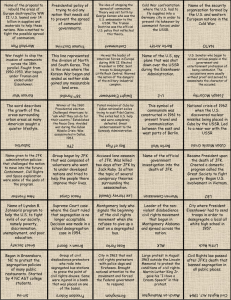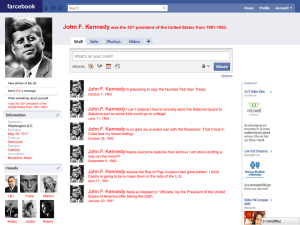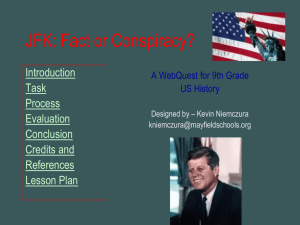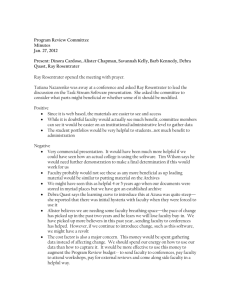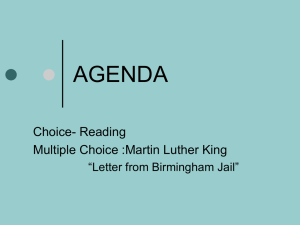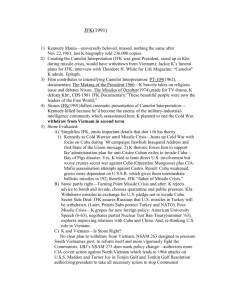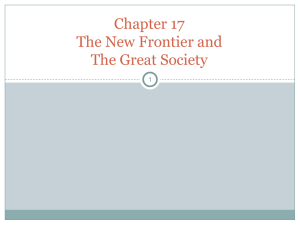Emily Lippitt JFK SPEECH
advertisement
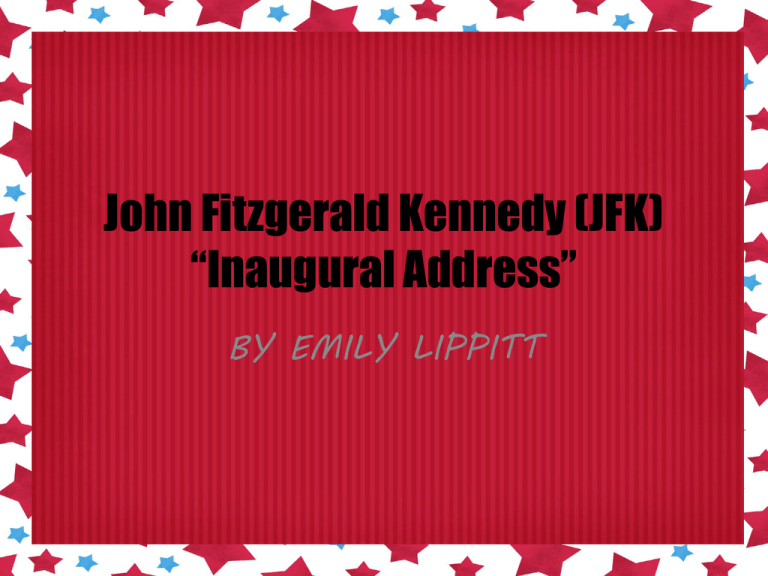
John Fitzgerald Kennedy (JFK) “Inaugural Address” BY EMILY LIPPITT BACKGROUND • Took place Friday, January 20, 1961 in Washington DC • JFK uses Ethos, Pathos, and Logos, paired along with other literary tools such as repetition, rhythm, and comparison. SUMMARY/ POINT • This inaugural speech establishes what John F. Kennedy’s vision is for the United States--actually it is more of a world vision--of global unity, supporting freedom and human rights for all humankind. • JFK believes there are still revolutionary beliefs being fought around the world. He does not want us to forget that we are all apart of this revolution. • We all need to work together as a global unit. Also, let our neighbors know that no other countries are going to take us over. SPEAKER • Speaker: JFK, president of the United states from 1961-1963 impacted the world and influenced the world greatly . SUBJECT • Subject- Essentially JFK is speaking on the growth of our country and what he intends to do to make this a better nation of togetherness. Occasion • Occasion: JFK’s inaugural address, in which he was speaking as the new president of the United States on January 20,1961. AUDIENCE • Kennedy delivered his Inaugural Address before an audience of twenty thousand people. The address was televised, and eighty million Americans watched; it was also broadcast over radios around the world. Being aware of the extensive audience, Kennedy consciously spoke not only to Americans but to the people around the globe as well. • Beyond the initial audience of people who heard the original speech can be added those who subsequently read it in newspapers or texts, those who heard recordings of the speech, and those who studied the speech in classrooms. AUDIENCE • JFK specifically addresses “Vice President Johnson, Mr. Speaker, Mr. Chief Justice, President Eisenhower, Vice president Nixon, President Truman, Reverend Clergy, and fellow citizens” PURPOSE • The purpose of an inaugural address is to outline the programs of the future (during his administration) and to introduce himself to America and the world. • In which he was essentially speaking to America to be involved and unify and work together, “ask not what your country can do for you but what you can do for your country” TONE • The tone of this speech is inspirational. Kennedy's youthful diction is combined with many parallelisms and anaphora's to emphasize the idea of moving forward. The tones are inspirational and powerful. ETHOS • President Kennedy opens his speech by establishing ethos or credibility, “For I have sworn before you and Almighty God the same solemn oath our forebears prescribed nearly a century and three-quarters ago.’’ • This excerpt tells the American people that he has followed the rules and has a legitimate responsibility to the American public as did the Presidents in the past. He is official. PATHOS • JFK uses words such as “We” to catch the emotions of people as if bringing everyone together as one. • The pathos part of his speech, “the torch has been passed to a new generation of Americans -- born in this century, tempered by war, disciplined by a hard and bitter peace, proud of our ancient heritage, and unwilling to witness or permit the slow undoing of those human rights to which this nation has always been committed, and to which we are committed today at home and around the world.” • Throughout Kennedy’s speech he uses emotionally charged words to draw in the American public and get them to relate to the topics at hand. LOGOS • JFK uses logos to convince the people. • Example : “we pledge our best efforts to help them help themselves, for whatever period is required -- not because the Communists may be doing it, not because we seek their votes, but because it is right. If a free society cannot help the many who are poor, it cannot save the few who are rich. ” • Here, JFK calls the public to join the effort to free the people stuck in communist countries by cleverly making it an issue of justice rather than power, and then comparing the success of their poor society, to the prosperity of our rich nation. This use of comparison is also a tool of rhetoric. REPETITION • JFK also uses repetition to persuade the American people. He begins several sections in the middle of his speech with the same phrase, “Let both sides. . .” then uses very strong verbs to call the public to action such as “explore,” “formulate,” “seek,” and “unite.” METAPHOR • Kennedy also uses the literary tool, the metaphor, “The energy, the faith, the devotion which we bring to this endeavor will light our country and all who serve it. And the glow from that fire can truly light the world.” • We cannot literally light the world on fire, but he means that we can influence the world as an incendiary nation. • The most famous sentence is immediately following that metaphor. It is a sentence, that was delivered with great enthusiasm, “And so, my fellow Americans, ask not what your country can do for you; ask what you can do for your country.” • This play on words is one of the most remembered phrases of all time, because JFK delivers it with rhythm and charisma. Analysis- Paraphrase • “…We shall pay any price, bear any burden, meet any hardship, support any friend, oppose any foe to assure the survival and the success of liberty.” Essentially JFK is speaking for a nation of equals. JFK would do anything for his country, just like every other American citizen; this being the underlying message of the sentence. • “But we shall always hope to find them strongly supporting their own freedom- and to remember that, in the past, those who foolishly sought power by riding the act of a tiger ended up inside.” working together we can build a better state and even world, but working apart, we can accomplish close to nothing and we don’t stand a chance. • “My fellow citizens of the world: ask not what America will do for you, but what together we can do for the freedom of man.” Not only s there a high importance for America as a whole, but the working together of different countries ad America to make the world a whole. • Essentially JFK stresses the importance of working together and becoming united. http://youtu.be/mxa4HDgfWFs
